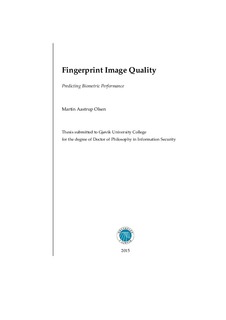| dc.contributor.author | Olsen, Martin Aastrup | |
| dc.date.accessioned | 2015-11-30T14:13:33Z | |
| dc.date.available | 2015-11-30T14:13:33Z | |
| dc.date.issued | 2015-11-30 | |
| dc.identifier.isbn | 978-82-8340-023-6 | |
| dc.identifier.issn | 1893-1227 | |
| dc.identifier.uri | http://hdl.handle.net/11250/2366306 | |
| dc.description.abstract | Biometric systems and fingerprint recognition systems in particular have become very widespread in the recent years, both in mobile devices and through increased usage in border controls and electronic national identification systems. One crucial aspect in any biometric system is that the quality of the data that enters system is of the highest possible quality to facilitate ease of interaction and a high level of biometric performance. In particular, the system error rates are sensitive to the quality of the enrolled sample due to subsequent interactions with the biometric system, results in a comparison being made against the enrolled sample. If the enrolled sample is of poor quality then the comparisons are more likely to result in a false non-match.
A performance evaluation taking the moisture content of skin into account and using modern optical fingerprint sensors revealed that the moisture level in the fingerprint has a bearing on the biometric performance. Biometric performance is sensitive to the moisture level of the skin and it was found that the effect is most pronounced on previous generation of sensors. Newer sensors are constructed in such a way that they are resistant to even high amounts of water on the sensing surface without compromising the fingerprint image quality.
The dataset resulting from the investigation is made available. The influence of the fingerprint position on the sensor platen was investigated and determined to be predictive of the biometric performance. Fingerprints with core points centered receive higher comparison scores on average than fingerprints with non-centered core points in genuine trials. With respect to the predictive performance of quality algorithms, a performance evaluation of state of the art algorithms showed that the predictive capabilities varies across datasets and comparison subsystem. The implementations of the evaluated state of the art algorithms is made available.
Dactyloscopic examiners assessments of fingerprint quality was investigated and found to have a bearing on genuine comparison scores, and a method towards a system which assists examiners in determining evidential value was proposed.
Concerning quality assessment on devices with limited computational resources, a method based on a clustering using receptive field and random forests was proposed and found to result in predictive performance comparable to state of the art methods.
An algorithm for discriminating between fingerprint image and images of other biometric modalities based on topological invariants was proposed. Experiments on separating fingerprint images and iris and face images show that the classification performance is improved over a state of the art spectral based algorithm. | nb_NO |
| dc.language.iso | eng | nb_NO |
| dc.relation.ispartofseries | Doctoral Dissertations at Gjøvik University College;5-2015 | |
| dc.subject | Fingeravtrykk | nb_NO |
| dc.title | Fingerprint Image Quality: Predicting Biometric Performance | nb_NO |
| dc.type | Doctoral thesis | nb_NO |
| dc.subject.nsi | VDP::Mathematics and natural science: 400::Information and communication science: 420::Security and vulnerability: 424 | nb_NO |
| dc.subject.nsi | VDP::Mathematics and natural science: 400::Information and communication science: 420::Simulation, visualization, signal processing, image processing: 429 | nb_NO |
| dc.source.pagenumber | 188 | nb_NO |
